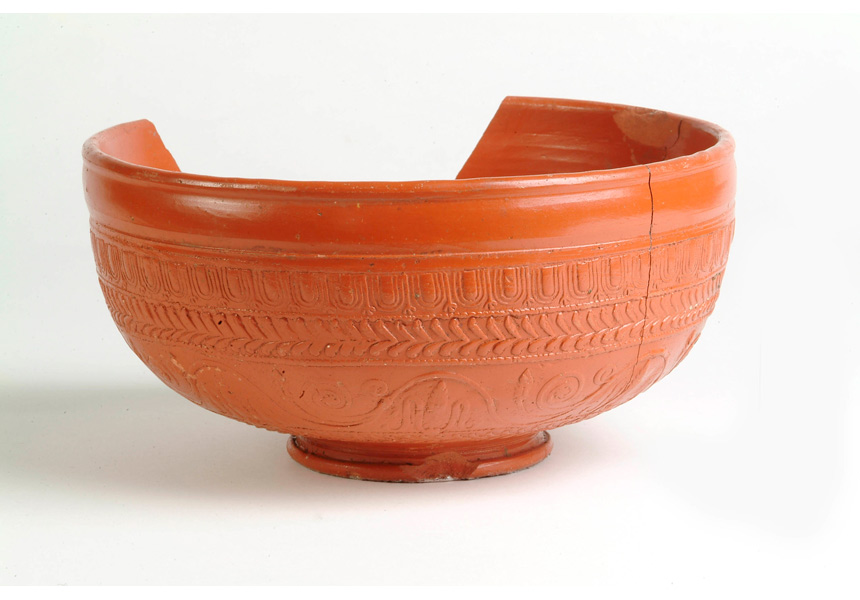Samian ware is a highly-prized Roman ceramic tableware, produced in Gaul (modern France), and exported throughout the empire. It is distinctive for its red/orange glossy appearance. Samian ware was produced in a variety of forms, and both plain and decorated examples were made. The Museum holds some 13,500 pieces of decorated samian ware.
The collection comprises material from the Guildhall Museum and London Museum, as well as later additions to the collection. The majority of the material has been collected from within the City of London, from late 19th-20th century building sites, either recovered archaeologically, or from donations or sales by workers on the sites.
Samian ware was produced from the 1st to the 3rd centuries, in three main areas of Gaul, South, Central and East. The area of production can sometimes be more narrowly identified, with major production centres being known from La Graufesenque (South Gaul), Le-Martres-De-Veyre (Central Gaul), Lezoux (Central Gaul) and Montans (South Gaul).
The production dates of this material are often identifiable, by the style of the decoration. Earliest forms were most commonly comprised of bands of decoration, with precise decorative forms, later examples were more freestyle with larger, less constrained designs.
The decorated samian forms were all produced in a mould; the mould would be formed from fine-grained clay which was thrown on a wheel, to produce the shape of the vessel needed and a smooth surface into which the design could be put. The design was produced by impressing individual stamps, or 'poincons' with the decorative detail on, into the mould. The stamps would be produced in positive relief, so the finished vessel would have the same decoration.
To produce the bowl, the mould was fixed to a potter's wheel, clay was put in the mould, and drawn up it as the wheel rotated, pressing the clay in to the pattern. The rim was formed above the mould. The vessel was then left to dry, causing it to shrink away from the mould, and allowing it to be easily removed. At this stage, the footring could then be added to or carved from the base of the bowl. After the vessel has dried, it was then dipped in a slip formed of a suspension of the vessel clay in water, and dried on a sanded surface (impressions or remains of sand are often found on the base of the footrings). When the slip was dried, the vessel would be fired in a kiln. Samian ware was mass produced, when a mould had been used, it could be cleaned and reused.
Maker's marks, in the form of a stamp of the potter's name, are sometimes found within the interior of the bowl, these would have been sunk in to the bowl, before the slip was applied. Other maker's marks, can be found on the exterior of the pot, as can mould maker's stamps, which would have been impressed in to the mould, before the pot was produced. Work at the kilnsites has enabled the active period for many potters to be narrowed down to a decade or two; so samian is very useful for dating on archaeological sites.








